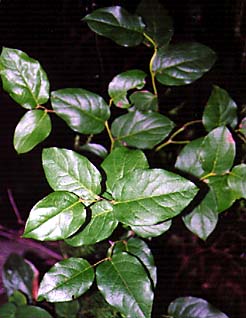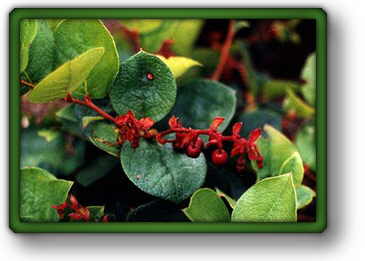 |
|
Gaultheria shallon, more commonly known as salal, is an important plant species of the northwest. Considered an understory shrub, this plant has many uses. ECOLOGY The average height of salal is 1.5 meters but can grow up to 5 meters in humid conditions. The leaves are dark green on the top but paler below with shallow saw-edges and pointed tips. They are thick, shiny, and oval shaped. Salal is a perennial evergreen with reddish to grayish bark, and begins to flower in May and June. The flowers are pink and white, and are described as bell or urn shaped. They grow in clusters on racemes, starting where the previous year’s growth ended. Salal berries are hairy and fleshy, with a reddish-blue to dark purple coloring. They are 6-10mm broad. The berries have a lot of tiny seeds, which give it a grainy or mealy texture. Salal is found in abundance in coastal regions of the United States and Canada up to 800m, and is one of the most common understory shrubs in the Northwest. Its habitat ranges from as far south as Santa Cruz, California up to southern Alaska. The habitat goes from the coast to as far east as the Cascade Mountain Range in Oregon, Washington, and British Columbia. Bogs, wet areas, and coniferous forests provide suitable habitats for salal. |
|
HISTORY Historically, salal has played a critical role in the lives of the native inhabitants of the Northwest. The name shallon is derived from kikwu-salu, the Chinook name for the plant. The berries were an important staple for many different tribes. Most tribes picked clusters of berries at the end of the summer when they are ripe. Then they ate them fresh or dried them out in cakes for later use. During large feasts, the Kwakwaka’wakw dipped the ripe berries in grease of oolichan (smelt), ate them individually off the cluster, and disposed of the stems in their fire. They also made cakes, but these were set aside for family meals and chiefs.
|
 |
|
ECONOMICS
Holidays create a rising demand for floral greens, and increase their value. However, wholesalers now can refrigerate plants for weeks until the price is highest without giving the harvesters the best rates. The internet has helped floral green companies sell salal across the world as well. |
POLICY AND MANAGEMENT
The floral green industry may soon be under agricultural law. This will cause many harvesters to become employees of certain buying sheds if they harvest in a region leased by the company. Once they sell salal back to the guying shed, they will automatically become employees of the buying shed. In this scenario, harvesters make less money but get workers compensation in return. |
|
One reason why so many problems exist in the salal industry is that the wrong people are creating the rules for harvesting. Harvesters are rarely included in policy-making, even though they are the ones out in the field. Often, policies are made in Washington, D.C. by lawmakers who have never been to the Olympic peninsula or met any harvesters. One buyer from the Olympic Peninsula suggested that “the ideal situation would be to have someone come from the Capital and come and say spend a week at [company name], just observing. They need to see the type of people that are picking, how hard pressed these people are…they need to come in here and get the firsthand experience, to see a picker walk through the door that’s near froze to death.” *compiled from a paper by C.W. George
|
 |